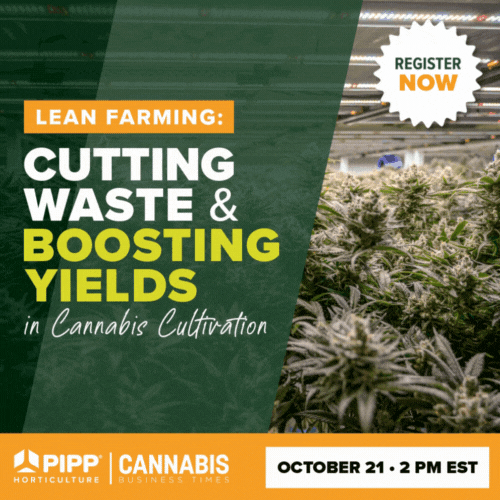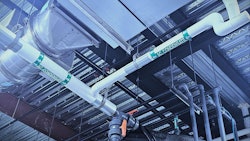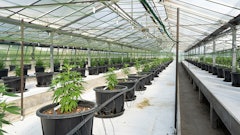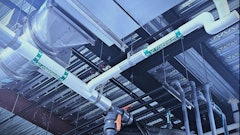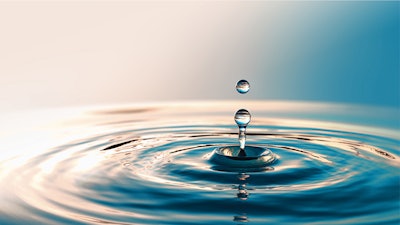
As water increasingly is viewed as a precious resource that should be safeguarded and used judiciously, regulatory pressures regarding commercial cultivation runoff are becoming progressively commonplace. These rules, meant to protect freshwater sources and aquifers as well as prevent eutrophication of water bodies (where nutrient runoff causes a dense growth of plant life and deprives aquatic animal life of oxygen), highlight the urgency for meticulous water management practices.
By adopting strategies to curtail water usage and leverage recirculation avenues like HVAC condensate and irrigation leachate, growers can demonstrate their commitment to sustainability and gain a competitive edge in an increasingly eco-conscious market.
Here, we navigate the nexus of resource efficiency, regulatory alignment, and commercial viability in the evolving commercial cannabis cultivation industry.
Ways to Decrease Excess Water Usage in Container Growing
In the Resource Innovation Institute’s (RII) “Water Circularity Best Practices Guide,” we note that “any facility can conserve water through best management practices, no matter its level of technology. … Just as important [as remediation] are the everyday decisions of growers and the often thankless tasks of preventative maintenance that reduce water waste.”
Ideal irrigation strategies will vary depending on substrate type and its qualities. In a November 2023 webinar, Marielle Taft, an RII Water Circularity Working Group member and a senior crop specialist at Grodan, shared how “the height of the container, the fiber orientation if it's stone wool—meaning vertical or horizontal fibers—the fiber diameter, the wetting agent and binder chemistry, the density, the particle size and particle heterogeneity, all of those qualities matter a lot and will dictate the irrigation strategy that needs to be deployed.”
By not choosing the appropriate substrate for container growing, cannabis growers open themselves up to a plethora of irrigation issues and excess water usage. For example, while dense substrates may increase the amount of water a container can hold and have good resaturation capabilities after a dry-down, it will take a lot of water and a higher flow rate to displace old fertilizer solutions. Excessively dense substrates “can also make it really challenging for growers to titrate down their nutrient solution as the crop's metabolism declines and plants approach [flowering],” Taft noted. “So it can require huge amounts of water and runoff to reduce the substrate EC [electrical conductivity], which unfortunately can also inadvertently send the plants a very vegetative message at a time when the grower might really want to be focusing on ripening the crop.”
At the other end of the spectrum, a low-density substrate can be free-draining, allowing growers to more easily manage EC, “but it will typically have poor resaturation capacity and less uniform nutrient distribution,” Taft highlighted.
Substrate and container volume are also highly correlated to water-usage efficiency. As we point out in the “Water Circularity” guide, “due to gravity’s pull, a tall container will hold less water than a short, squat container, even if their substrate volumes are the same. The tall container is said to have less container capacity, beyond which, any more water that is applied leaches out from the bottom of the container. Short, squat containers will stay wet longer, making them less likely to cause water stress but more likely to be overwatered.”
On substrate volume, Taft pointed out that growers leveraging larger substrate volumes (that hold more water), may be inclined to irrigate more heavily but less frequently. “In these scenarios, the root zone can remain excessively wet, drybacks can happen at an extremely low rate, and the grower is constantly at risk of overwatering when trying to adjust the substrate EC,” she said.
Conversely, not using enough substrate will lead to more frequent irrigation events as dry backs happen too quickly, leading to excessive water use and potentially EC spikes, salt concentration and precipitation, and overall osmotic stress.
Taft advised webinar attendees that a good substrate volume range to target for cannabis is 18 to 26 liters per square meter.
“Where we fall within that range can depend on a variety of factors, including the vegetative time, whether … in a single- or a double- or even a triple-tiered vertical racking system, whether they intend to top their plants to extend the vegetative time or decrease the plant density,” she said.
When determining how much water to give plants in every irrigation event, Taft suggested cannabis growers aim for “1% to 6% of the total substrate volume you're using,” adding that if a grower is using multiple or stacked substrates to use 1% to 6% of that cumulative volume.
Careful monitoring of root zone water content and EC can help cannabis growers avoid overwatering and wasting fertilizer or underwatering that can lead to excessive EC levels that damage root tips and cause toxicity or deficiency symptoms in leaves (nutrient lockout). “We can walk up to the edge of a lot of these ideal water content and EC thresholds intentionally and proactively without exceeding them, pushing plants to their physical and chemical production limits, but not causing harm that hampers production,” she said.
Recirculation Opportunities
Many cannabis growers leverage hydroponic cultivation strategies to grow their crops. In our “Water Circularity” guide, we share the findings of a 2021 academic study on vegetable crops that “reported hydroponic systems were more water efficient than drip irrigation applied to pots of compost-based substrate, while also capable of producing higher quality produce.” The same rings true for many hydroponic cannabis operations.
While hydroponic growers can certainly be proud to be using less water, both they and container growers can further reduce the amount of water that is both brought into the facility and drained to waste by turning to circularity solutions.
Water recirculation systems enable cannabis growers to capture otherwise stranded or drained water sources that are already in their facility, diverting these from going to the municipal sewer system (if allowed in the jurisdiction), a septic tank, or collection pond. With modern technology, it is possible to divert nearly all wastewater back into the facility for reuse.
These technologies are common in the manufacturing industry, said Water Circularity Working Group member Dane Sheldon, director of business development at AQUASGROUP, and are starting to make their entry into the controlled environment agriculture and cannabis industries.
One generally easy-to-reuse water source is condensate from HVAC systems or greenhouse roofs. Condensate is a source of (nearly) pure water that if collected can be recirculated and reused in a variety of ways in a cannabis cultivation operation, including for irrigation, or to dilute incoming municipal or well-water that may have higher total dissolved solids (TDS) and EC, or other qualities undesirable for cultivation (e.g., hardness, metals, etc.).
There are considerations to be aware of when recirculating condensate, namely contaminants that can form in the water or be pulled from the environment. “There's definitely potential for biofouling of that water source. … You [also] can pick up some metals just based on what plumbing it might be running through on its way to any collection tanks,” Sheldon said.
Using a water purification system to remove those contaminants and regular maintenance of those water lines will ensure no pathogens affect the crops. When selecting a product to remove biofilm from those lines, Sheldon suggested cannabis growers keep an eye out for “sanitizers that are going to dissociate into benign constituents like CO2 and water,” and avoid products like bleach that can damage crops and force growers to thoroughly flush lines, increasing water usage.
Growers can also aim to minimize biofouling and water reservoir contamination by plumbing in a way that ensures drain lines stay flooded, using copper plumbing for condensate drains (this will require monitoring of dissolved copper in the water), and directing condensate to an intermediate tank for more aggressive biocontrol before moving it to the main water reservoir.
Irrigation leachate can be an additional significant source of reusable water: Leach fractions are most often 10% to 20% of the irrigation volume applied but can be as high as 60% in some circumstances, per the “Water Circularity” guide. That said, reusing that leachate comes with its unique challenges. Growers looking to reuse leachate may encounter “a combination of dissolved constituents in the water—the nutrients, the inorganic salts—and then you're going to have suspended solids in the water” from growing media and other drain-related contaminants, Sheldon said.
Cannabis growers will likely require a combination of water purification technologies to make good use of that irrigation leachate. For example, high-capacity multimedia stage filters that leverage a combination of gravel, sand, charcoal, and/or granular activated carbon can remove solids, while dissolved solids (i.e., nutrients) can be removed via membrane filtration such as reverse osmosis (RO) units or resin ion exchange systems.
Resin ion exchange systems swap out positive and negatively charged dissolved ions contained in the water (inorganics) for hydrogens and hydroxyls to make H2O, Sheldon said. “It's very nice in that you can get very high flow rates through it, it's efficient, and there's not a reject stream,” he said, adding that the drawbacks are the systems’ generally limited capacity and the need to regenerate (i.e., flush) the resin filter on- or off-site (which creates a waste stream).
Evaporation is another method to treat water for reuse, but it has traditionally not been explored in agriculture or cannabis due to the energy required to boil the water and the waste management costs associated with the solid remains. However, if cannabis growers can capture and recirculate the CO2 generated from the propane burners that power them for crop supplementation, their carbon footprints can be mitigated and make these systems even more cost-effective.
Additionally, some evaporation system manufacturers offer units that operate in a vacuum, referred to as vacuum distillation, where water can be evaporated at temperatures as low as 90 degrees Fahrenheit. While they come with a higher upfront cost, these systems have lower energy requirements (and therefore lower ongoing costs). Evaporative units are likely best considered by facilities looking to achieve zero-discharge status and/or address regulator directives about water waste discharge.
Water recirculation is not a new concept in other industries—although it may be a subject new to some cannabis growers. And as with most things in the cannabis cultivation industry, when it comes to water circularity, the devil's in the details.
Robert Eddy, M.S., is resource efficiency horticulturist at Resource Innovation Institute.

